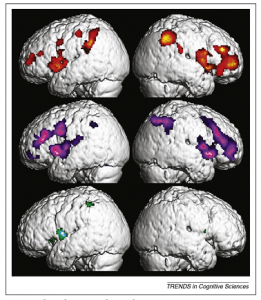Presented within the flow of the lives of real people and fictional characters, this is a monthly exploration of how parts of the brain work.
You are feeling sleepy…
by Leena Prasad
The tall man on stage, dressed in a business suit, is clucking like a chicken. A pretty redhead, also on the stage, laughs whenever the hypnotist says the word ‘paper’. A young boy says the word ‘tomato’ whenever the hypnotist touches him on the head.
Henry watches with fascination and is glad that he did not volunteer to be one of the performers’ guinea pigs. He wonders what hypnosis does to the brain.
Dr. Amir Raz, research professor at McGill University in Canada, conducted a study in which participants were able to perform better at a color recognition game while hypnotized. Normally, if an English-speaking person is asked to quickly identify the colors blue–red–green, they become momentarily confused because of the dissonance between the words and the colors. Under hypnosis, there was less confusion and subjects were able to identify the colors quicker because they were able to ignore the meaning of the words and simply look at the color.
Other neuroscientists are studying hypnosis in different contexts. Dr. David Oakley and Dr. Peter Halligan of Cardiff University conducted a study in which they mapped neural response to pain. The MRI’s on the right show blood flow within the brain while the patient was exposed to various  conditions. The top figure shows the blood flow when the subject experienced pain from a physical stimulus. While under hypnosis, subjects were told that pain will be inflicted but no pain stimulus was actually used. Regardless, the subjects experienced pain as demonstrated by the middle MRI. Although not exactly the same, the top and middle images are somewhat identical. The bottom image shows much less activity in the brain when the subjects were simply told to imagine pain.
conditions. The top figure shows the blood flow when the subject experienced pain from a physical stimulus. While under hypnosis, subjects were told that pain will be inflicted but no pain stimulus was actually used. Regardless, the subjects experienced pain as demonstrated by the middle MRI. Although not exactly the same, the top and middle images are somewhat identical. The bottom image shows much less activity in the brain when the subjects were simply told to imagine pain.
If Henry had volunteered to be hypnotized, he could have been on stage laughing at the mere mention of the word paper. It is possible that he will respond in the same manner as the study subjects in terms of his ability to identify the colors and to feel ghost pain. Not everyone is hypnotizable, however, and the subject has to be a willing participant in order for hypnosis to work.
As in most areas of brain research, the study of hypnosis has potential. Neuroscientists are in the beginning stages of studying the power of this ancient practice and are finding brain activity correlation with hypnosis. If Henry conducts a web search, he will find documentation of studies that show how hypnosis plays out within the neural networks of the brain.
Leena Prasad has a journalism degree from Stanford and her writing portfolio can be found at FishRidingABike.com. Links to earlier stories in her monthly column can be found at WhoseBrainIsIt.com.
Josh Buchanan, a UC Berkeley graduate, edits this column with an eye on grammar and scientific approach.
Dr. Nicola Wolfe is a neuroscience consultant for this column. She earned her Ph.D. in Clinical Psychopharmacology from Harvard University and has taught neuroscience courses for over 20 years at various universities.
References:
- Blakeslee, Sandra, This Is Your Brain Under Hypnosis, New York Times, Nov., 22, 2005
- Raz, Amir., PhD; Shapiro, T., MD; Fan, Jin, PhD; Posner Michael I., PhD, Hypnotic Suggestion and the Modulation, Arch Gen Psychiatry. 2002;59:1155-1161
- Oakley, David A., Halligan, Peter W., Hypnotic suggestion and cognitive neuroscience, Trends in Cognitive Sciences, Vol.xxx No.x.


Pingback: Synchronized Chaos » Blog Archive » Synchronized Chaos June 2013 – Glimpses of New and Familiar Worlds